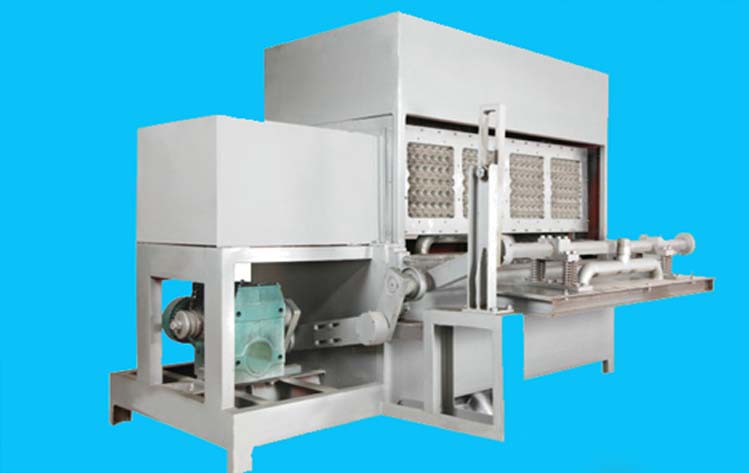Egg Tray Machine
When loading eggs, we need to use egg trays, especially on farms. Egg tray can be used to prevent unnecessary broken loss caused from the egg stacking and improper squeeze, which is good for egg storage. The egg tray machine is a kind of egg tray making equipment that specializes in the production of egg tray.
The egg tray machine takes recycled paper as raw material in production. Its working process mainly belongs to physical reaction with only a small amount of chemical items added as waterproofing agent. And these chemicals are basically all retained in the finished product after the drying. There is no discharge pollution. So the egg tray machine is the environmentally friendly pulp egg tray equipment.
The pulp egg tray machine is mainly composed of the pulping system, the forming system, the drying system and the packing system. The pulp egg tray machine uses recycled papers such as old newspapers, magazines, and cartons as raw materials to produce pulp formed egg trays through a series of processes such as screening, thickening, forming and drying.
The main frame structure of the pulp egg tray machine selects national standard channel steel as the supporting parts of main machine, and the shaft selects solid carbon steel. This type of steel has good torque and toughness and it is the best choice for main shaft. The mould plate and water tank are made of corrosion resistant and lightweight materials.


Components
- Pulping system: hydraulic repulper, pulp pump, vibrating screen, refiner, mixer, etc.
- Forming system: drum forming machine, mould, air compressor, air compressor tank, vacuum pump, vacuum tank, high pressure water pump, steam water separation pump, etc.
- Drying system: hot air blower, moisture exhaust fan, wet exhaust pipe, burner, combustion chamber, conveyor belt, chain, etc.
- Packaging system: stacker, compaction equipment, baler, etc.
Working flow
Recycled paper is added to hydraulic repulper with water and sent to storage tank, and the pulp is mixed evenly by the mixer in the storage tank and conveyed to the supply tank. And the pulp is stirred to a certain concentration in the supply tank and sent to the forming machine, and egg trays will be produced here and sent to the drying section through the conveyor belt. The egg trays will get dried, collected and packaged finally. In addition, the vacuum pump can pump the unused water inside the forming machine to the water recycling tank, and the tank can transfer water to the repulper and the storage tank to achieve water recycling purpose.


Equipment type
According to automatic level, the egg tray machine can be divided into fully automatic type and semi automatic type. According to single hour production quantity, it can be divided into 2000pcs type, 3000pcs type, 4000pcs type, 5000pcs type and 6000pcs type. It can be divided into four design types, each of which has its own different roles.
1. Flip type egg tray machine
Flip type egg tray machine is to place a mould inside a pulp tank and obtain design shape by suction method, and then flip upside to get out the formed wet paper tray. The production speed is 3times/min. This machine is small in size, similar to the up-and-down moving forming machine. And its production capacity is smaller than that of the rotary type, and it is proper for small batch production.
2. Rotary type egg tray machine (Also called Drum type egg tray machine)
Common rotary egg tray machine consists of transmission device and adjustment device, rotary drum, ejector, cleaner and controller. Currently common rotary egg tray machine has four drums, eight- drums and twelve drums.
3. Swing egg tray machine
Swing egg tray machine is that lower mould plate of the lower rotating body does suctioning, filtering and dehydrating in the pulp tank, and meanwhile the upper and lower rotating bodies do reciprocal swings and clamp the upper and lower mould plates in right position, finally vacuum suction completes the forming operation. Swing egg tray machine is characterized by small volume and flexible installation position. The forming machine carries smaller pressure. This machine is suitable for the production of bulk egg trays.
4. Up-and-down moving egg tray machine
Up-and-down moving egg tray machine is that the mould moves up and down and sinks into the water tank for suctioning and filtrating. The daily output of the whole production line is 3-4times/min.
Different types of egg tray making machine have different effects. We must pay more attention to energy conservation and environmental protection.
Backed with huge industry experience and market understanding, AGICO is involved in providing a wide variety of Egg Tray Machines for our valued patrons. We are the leading Manufacturer of Egg Tray Machine and Egg Tray Making Machine. We offer our products to clients in many options and at a very economical and competitive price.

